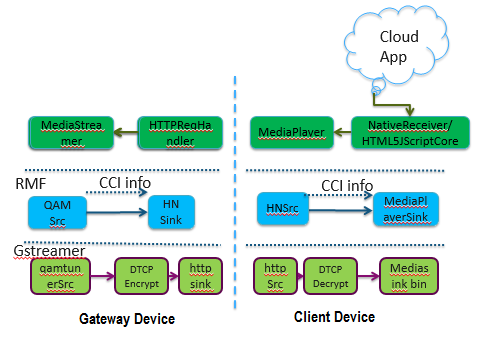...
There are two gstreamer filter elements are used for content encryption/decryption. DTCP
- DTCP Encrypt:
The "dtcpencrypt" is a gstreamer filter element which encrypts
...
- incoming MPEG 2 SPTS stream and pushes encrypted data to the source pad. DTCP encrypt requires initialization of DTCP libs done in RMF
...
- application (e.g Media Streamer) which includes creating socket and listening for AKE request, authenticate and send exchange key to Sink device upon DTCP request from sink EMO It support Authentication and Key Exchange (AKE) from DTCP client. It encrypts the video stream using DTCP Encryption Mode Indicator (EMI)
...
- DTCP Decrypt:
The "dtcpdecrypt" is a gstreamer filter element is used to decrypt the MPEG2 SPTS video streams. It performs Authentication and Key Exchange (AKE) to DTCP server.
DTCP Protection
All DTCP encryption and dcryption decryption uses common set of provided gstreamer elements, The gstreamer elements uses DTCP manager API. Each SoC provides binary DTCP encryption/decryption library to support the DTCP Manager API.
How to enable/disable DTCP?
At first, user need to verify that the current build of the box supports to enable/disable DTCP.
If it's yes, following the next steps
- Copy rmfconfig.ini under /etc to /opt
cp /etc/rmfconfig.ini /opt - Change the configuration parameter "FEATURE.DTCP.SUPPORT" value to TRUE or FALSE in file /opt/rmfconfig.ini
vi /opt/rmfconfig.ini
Save the configuration file and reboot the box
$ sync
$ reboot
Check AV for the box once it's up.
DTCP Use Case: Live Playback using QAM Source

- The left side of the figure is considered for gateway device.
- The right side of the figure is considered for client device.
- In case of live stream the HTTPReqHandler will receive a request from client box and the MediaStreamerMedia Streamer.
- will sets an pipeline between QAM Source and HN Sink.
- QAM Src element receives the data from the tuner and sends to the HN Sink.
- In the client side another pipeline has created between HNSrc and MediaPlayerSink.
- HNSrc receive the incoming data from HNSink and feeds to the MediaPlayerSink for live playback.
DTCP encryption and decryption are used for protecting contents over network.
References
![]()